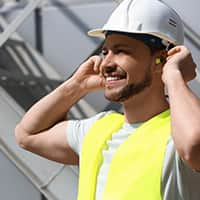OSHA’s Requirements for Hearing Conservation
Written by Staff Writer

Noise is often a part of industrial, construction and similar workplaces — so much so that it can be easy to forget it’s there. Unfortunately, that noise can damage your ability to hear. That’s one of the big reasons why hearing conservation regulations exist.
The Occupational Safety Health Administration (OSHA) requires employers to provide hearing conservation training, noise exposure monitoring, ear protection and other important safety measures when workplaces exceed specific audio levels.
Accurate information on OSHA’s hearing conservation program is important for everyone on the job. The responsibility for hearing conservation program management falls on employers. Employees must be educated to properly use hearing protection devices and other precautions.
National Noise Regulations
According to OSHA, “Noise, or unwanted sound, is one of the most pervasive occupational health problems. It is a by-product of many industrial processes.” Loud sounds can cause noise-induced hearing loss and possibly cause other health problems. How much damage depends on the intensity of the sound and the duration of the exposure. Testing and protection are required for sounds above 85 dBA.
Prolonged exposure to high levels of noise can damage your ear drums. You shouldn’t have to sacrifice your ability to hear for your job. That is why regulators established requirements for jobsites with high noise levels.
Regulators developed a program to prevent initial damage to a worker’s ability to hear. Where damage has already taken place, the priority becomes preserving and protecting remaining sensory acuity. Both goals start with equipping workers with the knowledge and personal protective equipment (PPE) necessary to safeguard themselves. Federal standards include provisions requiring management to measure noise levels; administer free annual ear exams, ear protection and training; and conduct evaluations of the adequacy of the PPE in use.
The requirements for the OSHA hearing conservation program also obligate management to maintain specific records of sound levels and test results. Each employee must take a benchmark test before or during the first year of working in a hazardous environment.
Those test results establish a baseline to which following annual tests are compared to see if the employee’s ability to hear is reduced. Workplaces must also engage in a periodic hearing conservation program evaluation to ensure current programs meet changing jobsite needs.
State Standards
The Occupational Safety and Health Administration is a federal organization. States can develop their own state-specific plans that add additional criteria beyond what the federal organization requires. California has the Division of Occupational Safety and Health (DOSH), often referred to as Cal/OSHA, which includes all the federal regulations and additional benchmarks determined by California as well.
California isn’t the only state with additional protective measures. We provide training that meets California, North Carolina and Nevada state plan requirements.
Online Auditory Safety Training
Sensory protection is included in Outreach Training programs like OSHA 10 and OSHA 30. These are nationwide general safety programs designed in conjunction with the U.S. Department of Labor.
As an authorized provider of Outreach Training, we offer educational courses designed to teach you current federal regulations and how to protect yourself and those around you on the jobsite.
We also offer in-depth state-specific programs. These include courses specific to the state of California and DOSH, like our Cal/OSHA 10-Hour Training for General Industry course and our Cal/OSHA 30-Hour Training for General Industry course, both of which cover California Title 8 Regulations in addition to federal rules.
Online instruction offers several benefits over in-person classes. By learning with us, you can:
- Take the course on any internet-connected device
- Set a pace that is right for you
- Save your progress automatically
- Instantly download your certificate of completion
Pick from one of the courses above or explore our extensive course catalog for more options. There’s no need to wait. You can sign up and start learning today!
